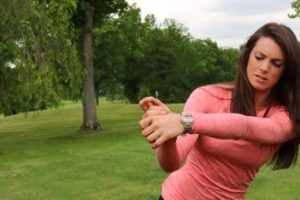Not all yoga is the best yoga for golf. Yoga’s effectiveness in sports is entirely dictated by the style of yoga and its application within the context of an understanding of the movement demands of the game. This is especially true for golf because it requires of an enormous range of rotational motion and velocity, as well as the ability to execute precise, controlled movements within a much shorter range. Spending hours working on hamstring lengthening to put your leg behind your head will do little for your golf game, and, in fact, could be impede functional movement.
A full golf swing off the tee requires powerful mobility through an enormous range of motion in two primary areas (the hips and thoracic spine). Any loss of range in these areas will put undue compensatory stress on the low back and knees—which require stability. Functionally integrated core and pelvic floor strength is also a requirement for exerting power and control over the club from back swing through impact and follow through. Essential to all stability, mobility and power in a swing—and, arguably, all human movements—is a functional diaphragm to properly position the rib cage for t-spine rotation and integration of the pelvic floor with core muscles, enabling velocity without a loss of balance or control.
This is why yoga training designed specifically to address these areas is the best “style” of yoga for golfers. Building off a foundation of functional diaphragmatic breathing, golfers can learn to leverage breathing mechanics for better thoracic rotation while also creating deep core, pelvic floor and low-back stability to promote enhanced hip mobility. And all the emphasis on proper breathing leads to even more benefits in performance…
When looking for a competitive edge, training for the mental game is just as important as the physical. Too often, golfers inadvertently let anxiety, coupled with shallow breathing, pull them into their sympathetic nervous system (fight or flight), which makes them feel even more anxious and less in control by stimulating increased production of stress hormones. By training their breathing, golfers can leverage it to tap their parasympathetic nervous system (PNS), lowering stress hormones, heart rate and blood pressure. With greater calm, they cultivate awareness and concentration that undeniably translates to better control of their mind and body on the green.
Click Here to View a Breathing Tutorial from Dana
About Dana:
Dana Santas is the creator of Radius Yoga Conditioning, a yoga style designed to help athletes move, breathe and focus better. She’s the yoga trainer for the Atlanta Braves, the Philadelphia Phillies, the Tampa Bay Rays, Tampa Bay Lightning, Orlando Magic and dozens of pros in the LPGA, PGA, National Football League, National Hockey League, National Basketball Association and Major League Baseball.
Connect With Dana:







Leave a Reply
Your email is safe with us.
You must be logged in to post a comment.